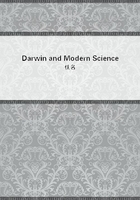
第192章
Only in those cases in which his ideas had become fully crystallised, did he attempt to deal with scientific matters in this journal. His second task was to write in voluminous note-books facts concerning animals and plants, collected on sea or land, which could not be well made out from specimens preserved in spirit; but he tells us that, owing to want of skill in dissecting and drawing, much of the time spent in this work was entirely thrown away, "a great pile of MS. which I made during the voyage has proved almost useless." ("L.L." I. page 62.) Huxley confirmed this judgment on his biological work, declaring that "all his zeal and industry resulted, for the most part, in a vast accumulation of useless manuscript." ("Proc.
Roy. Soc." Vol. XLIV. (1888), page IX.) Darwin's third task was of a very different character and of infinitely greater value. It consisted in writing notes of his journeys on land--the notes being devoted to the geology of the districts visited by him. These formed the basis, not only of a number of geological papers published on his return, but also of the three important volumes forming "The Geology of the voyage of the 'Beagle'". On July 24th, 1834, when little more than half of the voyage had been completed, Darwin wrote to Henslow, "My notes are becoming bulky.
I have about 600 small quarto pages full; about half of this is Geology."("M.L." I. page 14.) The last, and certainly not the least important of all his duties, consisted in numbering, cataloguing, and packing his specimens for despatch to Henslow, who had undertaken the care of them. In his letters he often expresses the greatest solicitude lest the value of these specimens should be impaired by the removal of the numbers corresponding to his manuscript lists. Science owes much to Henslow's patient care of the collections sent to him by Darwin. The latter wrote in Henslow's biography, "During the five years' voyage, he regularly corresponded with me and guided my efforts; he received, opened, and took care of all the specimens sent home in many large boxes." ("Life of Henslow", by L. Jenyns (Blomefield), London, 1862, page 53.)Darwin's geological specimens are now very appropriately lodged for the most part in the Sedgwick Museum, Cambridge, his original Catalogue with subsequent annotations being preserved with them. From an examination of these catalogues and specimens we are able to form a fair notion of the work done by Darwin in his little cabin in the "Beagle", in the intervals between his land journeys.
Besides writing up his notes, it is evident that he was able to accomplish a considerable amount of study of his specimens, before they were packed up for despatch to Henslow. Besides hand-magnifiers and a microscope, Darwin had an equipment for blowpipe-analysis, a contact-goniometer and magnet;and these were in constant use by him. His small library of reference (now included in the Collection of books placed by Mr F. Darwin in the Botany School at Cambridge ("Catalogue of the Library of Charles Darwin now in the Botany School, Cambridge". Compiled by H.W. Rutherford; with an introduction by Francis Darwin. Cambridge, 1908.)) appears to have been admirably selected, and in all probability contained (in addition to a good many works relating to South America) a fair number of excellent books of reference. Among those relating to mineralogy, he possessed the manuals of Phillips, Alexander Brongniart, Beudant, von Kobell and Jameson: all the "Cristallographie" of Brochant de Villers and, for blowpipe work, Dr Children's translation of the book of Berzelius on the subject. In addition to these, he had Henry's "Experimental Chemistry" and Ure's "Dictionary" (of Chemistry). A work, he evidently often employed, was P.
Syme's book on "Werner's Nomenclature of Colours"; while, for Petrology, he used Macculloch's "Geological Classification of Rocks". How diligently and well he employed his instruments and books is shown by the valuable observations recorded in the annotated Catalogues drawn up on board ship.
These catalogues have on the right-hand pages numbers and descriptions of the specimens, and on the opposite pages notes on the specimens--the result of experiments made at the time and written in a very small hand. Of the subsequently made pencil notes, I shall have to speak later. (I am greatly indebted to my friend Mr A. Harker, F.R.S., for his assistance in examining these specimens and catalogues. He has also arranged the specimens in the Sedgwick Museum, so as to make reference to them easy. The specimens from Ascension and a few others are however in the Museum at Jermyn Street.)It is a question of great interest to determine the period and the occasion of Darwin's first awakening to the great problem of the transmutation of species. He tells us himself that his grandfather's "Zoonomia" had been read by him "but without producing any effect," and that his friend Grant's rhapsodies on Lamarck and his views on evolution only gave rise to "astonishment." ("L.L." I. page 38.)Huxley, who had probably never seen the privately printed volume of letters to Henslow, expressed the opinion that Darwin could not have perceived the important bearing of his discovery of bones in the Pampean Formation, until they had been studied in England, and their analogies pronounced upon by competent comparative anatomists. And this seemed to be confirmed by Darwin's own entry in his pocket-book for 1837, "In July opened first notebook on Transmutation of Species. Had been greatly struck from about the month of previous March on character of South American fossils..."("L.L." I. page 276.)